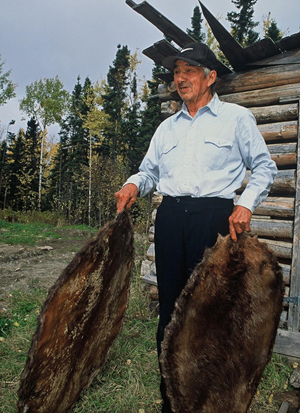Beyond the furthest reach of highways, electric lines, and suburbs and farms that tend to dominate southern Manitoba and Ontario lies a 43,000 square kilometer (16,600 square miles—about the size of Denmark) expanse of rugged and intact boreal forest where a number of First Nations still lead highly traditional ways of life. Although more modern technologies such as guns and gas-powered boats have been integrated into their culture, traditional activities such as hunting, foraging, trapping, and fishing remain central to their everyday lives and culture.

John Charles MacDonald, a trapper from Poplar River.
Credit: Garth Lenz
This region, which has been named Pimachiowin Aki or “Land that gives life” in Ojibwe, is home to bears, wolves, moose, and some of Canada’s largest and healthiest herds of the highly threatened Woodland caribou south of Hudson Bay. The vast lacework of rivers and lakes provide some of the most abundant and stable populations of freshwater fish, including sturgeon, walleye, and lake trout. It also provides a critical safety net for some of our most threatened migratory songbirds, including the Canada Warbler (80% decline), Olive-sided Flycatcher (79% decline), and Rusty Blackbird (90% decline). Pimachiowin Aki is within the world’s largest remaining block of intact forest and is virtually the only remaining large intact block of southern boreal forest left in North America.
Last remaining intact forests globally (largest in red, followed by yellow and then green).
Credit: Global Forest Watch Canada
The combination of its high biological values and support of traditional ways of life make Pimachiowin Aki truly unique within the global context. Hoping to keep these values and ways of life intact for future generations, the First Nations who call this land home came together in the last decade to better protect it from the ever-expanding industrial footprint from the south. After years of planning and discussions it was decided that Pimachiowin Aki would make an ideal candidate to become a UNESCO World Heritage Site.
Campaign for The Land that Gives Life:
These efforts have made considerable ground in the past few years, boosted further in 2009 when the government of Manitoba announced it was adding $10 million in additional funding to see these dreams come to fruition. The formal application to become a World Heritage Site is being worked on and is expected to be submitted in the next year or so, however, like most good causes, they have run into some funding issues. If you would like to donate to this cause you can do so here.

The Canada Warbler, in decline, would benefit from the UNESCO site.
Credit: Jeff Nadler
Here are a few more videos they have put together to better educate people about both the land and their efforts to protect it. I highly recommend taking a couple of minutes to view them as they are very powerful and there are lots of birds and bird sounds in them too! Look for the American White Pelicans, Common Mergansers, Bald Eagle and listen for the songs of White-throated Sparrow, Red-eyed Vireo, Yellow Warbler, and Tennessee Warbler among others.
Fly Over the Boreal Forest of Manitoba-Ontario:
Taking Care of the Land: Pimachiowin Aki:
A Journey to a UNESCO World Heritage Site:
A First Nations Healing Camp in The Land that Gives Life:


